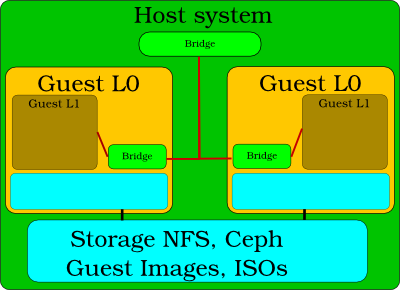-
Notifications
You must be signed in to change notification settings - Fork 0
Virtual Test Environment for Multihost test
For multi-host tests more real computers are required. It is possible to use two virtual guests for most of autotest tests except for virt-tests (kvm, libvirt, ...). It's possible to use Nested Virtualization to serve as first level (L0) guests and run nested guests inside them.
This page explains, how to setup (Fedora/RHEL) and use single computer with nested virtualization for such cases. Be careful that nested virtualization works usually right, but there are cases where it might lead to hidden problems. Do not use nested virtualization production testing.
-
Emulated:
- qemu very slow
-
hardware accelerated:
-
Hardware for the accelerated nested virtualization
AMD Phenom and never core extension (smv, NPT) Intel Nehalem and never core extension (vmx, EPT) -
Software which supports the accelerated nested virtualization
kvm, xen, vmware, .... almost the same speed like native guest (1.0-0.1 of native quest performance). Performance depends on the type of load. IO load could be quite slow. Without vt-d or AMD-Vi and network device pass through.
-

-
Intel CPU
options kvm_intel nested=1to the end of some modules config file /etc/modprobe.d/modules.conf -
AMD CPU
options kvm_amd nested=1to the end of some modules config file /etc/modprobe.d/modules.conf
-
Intel CPU
-
Virtual manager
Procesor config->CPU Features->vmx set to require -
Native qemu-kvm
qemu-kvm -cpu core2duo,+vmx -enable-kvm .....
-
Virtual manager
-
AMD CPU
-
Virtual manager
Procesor config->CPU Features->svm set to require -
Native qemu-kvm
qemu-kvm -cpu qemu64,+svm -enable-kvm .....
-
Virtual manager
Connect to host bridge with guest L0 bridge without DHCP (dhcp collision with host system dhcp).
-
Destroy libvirt bridge which contain dhcp.
-
Enable network service systemctl enable network.service
-
Add new bridge
virbr0manually and insert to them L0 network adaptereth0which is connected to host bridge#interface connected to host system bridge vi /etc/sysconfig/network-scripts/ifcfg-eth0 NM_CONTROLLED="no" DEVICE="eth0" ONBOOT="yes" BRIDGE=virbr0 #Bridge has name virbr0 for compatibility with standard autotest settings. vi /etc/sysconfig/network-scripts/ifcfg-virbr0 DHCP_HOSTNAME="atest-guest" NM_CONTROLLED="no" BOOTPROTO="dhcp" ONBOOT="yes" IPV6INIT="no" DEVICE=virbr0 TYPE=Bridge DELAY=0
and for sure disable NetworkManager systemctl disable NetworkManager.service
modprobe kvm-intel or modprobe kvm-amd should work
cd autotest/client/tests/virt/qemu/
sudo rm -rf results.*; sudo ../../../../server/autoserv -m guestL0_1,guestL0_2 multi_host.srv
- Start autotest frontend RPC or WEB interface https://github.com/autotest/autotest/wiki/SysAdmin
- Select multi_host test from pull-request https://github.com/autotest/autotest-server-tests/pull/1